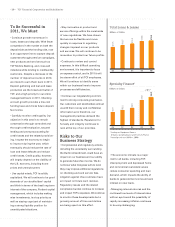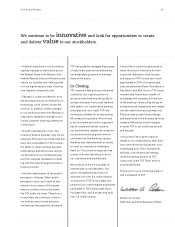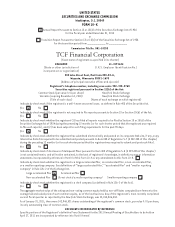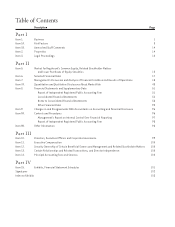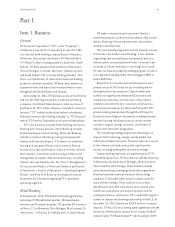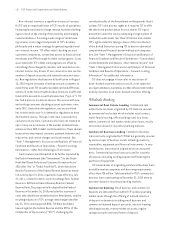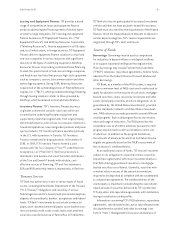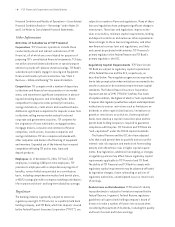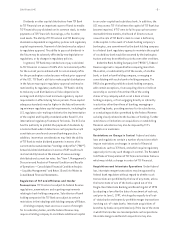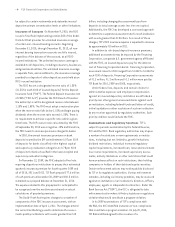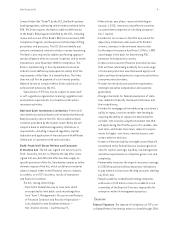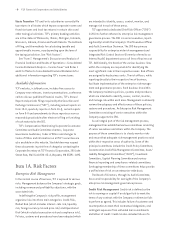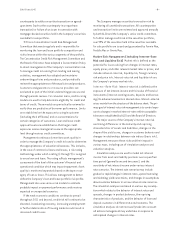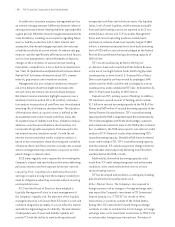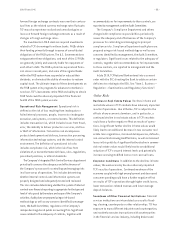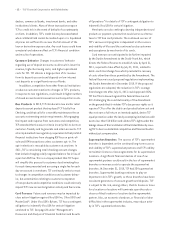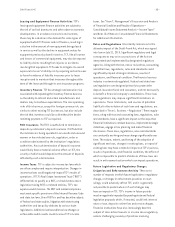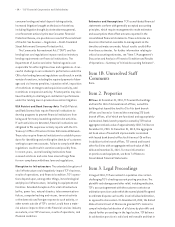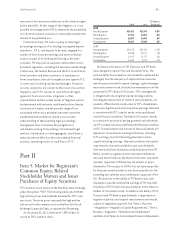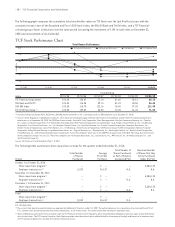TCF Bank 2010 Annual Report Download - page 22
Download and view the complete annual report
Please find page 22 of the 2010 TCF Bank annual report below. You can navigate through the pages in the report by either clicking on the pages listed below, or by using the keyword search tool below to find specific information within the annual report.• 6 • TCF Financial Corporation and Subsidiaries
be subject to certain nationwide and statewide insured
deposit maximum concentration levels or other limitations.
Insurance of Accounts On November 9, 2010, the FDIC
issued a Final Rule implementing section 343 of the Dodd-
Frank Act that provides for unlimited insurance coverage
of certain non-interest bearing accounts. Beginning
December 31, 2010, through December 31, 2012, all non-
interest bearing transaction accounts are fully insured,
regardless of the balance of the account, at all FDIC-
insured institutions. The unlimited insurance coverage is
available to all depositors, including consumers, businesses,
and government entities. This unlimited insurance coverage
is separate from, and in addition to, the insurance coverage
provided to a depositor’s other deposit accounts held at an
FDIC-insured institution.
The FDIC has set a designated reserve ratio of 1.35%
($1.35 for each $100 of insured deposits) for the Deposit
Insurance Fund (“DIF”). The Federal Deposit Insurance Act
of 2005 (“FDIC Act”) provides the FDIC Board of Directors
the authority to set the designated reserve ratio between
1.15% and 1.50%. The FDIC must adopt a restoration plan
when the reserve ratio falls below 1.15% and begin paying
dividends when the reserve ratio exceeds 1.35%. There is
no requirement to achieve a specific ratio within a given
timeframe. The DIF reserve ratio calculated by the FDIC
at September 30, 2010 was a negative .15% and therefore,
the FDIC needs to increase premiums charged to banks.
In 2010, the annual insurance premiums on bank
deposits insured by the DIF varied between $.07 per $100
of deposits for banks classified in the highest capital
and supervisory evaluation categories to $.78 per $100
of deposits for banks classified in the lowest capital and
supervisory evaluation categories.
On November 12, 2009, the FDIC adopted a final rule
requiring depository institutions to prepay their estimated
quarterly insurance premium for fourth quarter 2009 and
all of 2010, 2011 and 2012. TCF Bank prepaid $77.6 million
of such premium on December 30, 2009 and $50.5 million
remained as a prepaid balance at December 31, 2010.
The expense related to this prepayment is anticipated to
be recognized over the next two years based on actual
calculations of quarterly premiums.
The Dodd-Frank Act requires changes to a number of
components of the FDIC insurance assessment, with an
implementation date of April 1, 2011. The changes amend
the current methodology used to determine the assess-
ments paid by institutions with assets greater than $10
billion, including changing the assessment base from
deposits to total average assets less tier one capital.
Additionally, the FDIC has developed a scorecard approach
to determine a separate assessment rate for each institution
with assets greater than $10 billion. As a result of these
changes, TCF’s FDIC insurance expense is expected to increase
by approximately $15 million in 2011.
In addition to risk-based deposit insurance premiums,
additional assessments may be imposed by the Financing
Corporation, a separate U.S. government agency affiliated
with the FDIC, on insured deposits to pay for the interest
cost of Financing Corporation bonds. Financing Corporation
assessment rates for 2010 ranged from $.0102 to $.0104 for
each $100 of deposits. Financing Corporation assessments
of $1.2 million, $1.2 million and $1.1 million were paid by
TCF Bank for 2010, 2009 and 2008, respectively.
Under federal law, deposits and certain claims for
administrative expenses and employee compensation
against an insured depository institution are afforded a
priority over other general unsecured claims against such
an institution, including federal funds and letters of credit,
in the liquidation or other resolution of such an institution
by any receiver appointed by regulatory authorities. Such
priority creditors would include the FDIC.
Examinations and Regulatory Sanctions TCF is
subject to periodic examination by the Federal Reserve,
OCC and the FDIC. Bank regulatory authorities may impose
a number of restrictions or new requirements on institu-
tions, including, but not limited to, growth limitations,
dividend restrictions, individual increased regulatory
capital requirements, increased loan, lease and real estate
loss reserve requirements, increased supervisory assess-
ments, activity limitations or other restrictions that could
have an adverse effect on such institutions, their holding
companies or holders of their debt and equity securities.
Certain enforcement actions may not be publicly disclosed
by TCF or its regulatory authorities. Various enforcement
remedies, including civil money penalties, may be assessed
against an institution or an institution’s directors, officers,
employees, agents or independent contractors. Under the
Bank Secrecy Act (“BSA”), the OCC is obligated to take
enforcement action where it finds a statutory or regulatory
violation that would constitute a program violation.
In its 2009 examinations of TCF’s compliance with
the BSA, the OCC identified instances of non-compliance
that constitute a program violation. On July 20, 2010,
TCF National Bank agreed to the issuance of a


